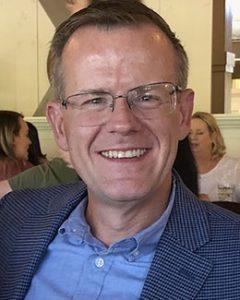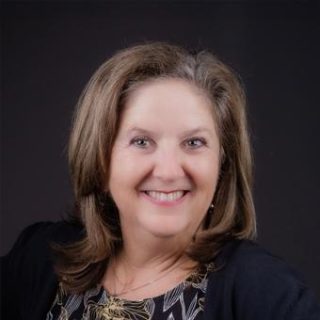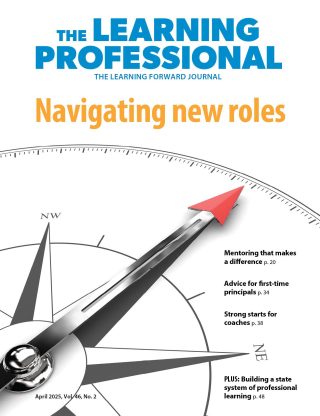DISTRICT MEMBER SPOTLIGHT
Tennessee district embeds professional learning standards
By David Timbs
October 2024
Often ranking in the top five Tennessee school districts for achievement and growth, Johnson City Schools invests heavily in professional learning and supports this work with a Learning Forward district membership.
Now in his 10th year with the district, David Timbs is the secondary education supervisor with a focus on the high school curriculum. With a core instructional leadership team, he also helps lead K-12 professional learning and manages the school improvement planning process.
According to Timbs, the district of about 8,000 students partly owes its success to a longstanding culture that values professional learning from the superintendent and school board and throughout the organization. “We rely heavily on the Standards for Professional Learning to guide everything that we do with the design and execution of professional learning in our district,” Timbs said.

What does professional learning look like in your district?
This year, we have three big bets: high-quality instructional materials supported by professional learning, job-embedded instructional coaches who help lead that professional learning, and instructional rounds.
There’s a professional development component to all instructional materials we adopt. Our teachers engage in professional learning on how to use a high-quality curriculum, which was vetted through a strenuous process.
Instructional coaches are job-embedded at the high school, and others serve across the district to model in the classroom to guide the implementation of our curriculum and lead weekly professional learning for our teachers.
Instructional rounds are new to our district this year. We are training our principals and assistant principals to lead these with the district staff.
A group of seven of us cover our instructional bands. This includes our supervisors of data, special education, and special programs. We will be on-site at our 11 schools at least twice during the year where the principals will lead a focused instructional round while we visit classrooms. Then we’ll talk about their professional learning strategies and look at how their checkpoint data is tracking toward year-end goals.
We highly value not interrupting class time. Professional learning is either on Saturdays or after school. Our instructional coaches meet primarily during teacher planning times. That’s one thing our district believes contributes to our success, along with our commitments to high-quality materials, instructional coaches, and instructional rounds.
What is the design of your district’s robust coaching program?
Over the years, instructional coaches have become so valuable in supporting classroom teachers. Having Title II funding earmarked for high-quality teacher development is a big driver for beginning this work. We have 18 instructional coaches, many of whom have attended at least one Learning Forward Annual Conference.
''Instructional coaches have become so valuable in supporting classroom teachers. Having Title II funding earmarked for high-quality teacher development is a big driver for beginning this work.'' #HQPL matters. Share on XBecause we have some new coaches, we took them through the Learning Forward Standards for Professional Learning at our kickoff to help them learn those so they understand the intentional professional learning design in our district.
The instructional coaches help lead professional learning and instructional rounds. We have two embedded in our high school — soon to be three — with backgrounds in math, reading, and science.
We have English language arts coaches in grades K-2, 3-5, and 6-8. We mirror that in math. We also employ two instructional coaches who focus on students with disabilities and work with the teachers. We have one coach who works with teachers on strategies for working with our English language learner population, who number around 400. We have two curriculum coaches embedded to direct our Response to Intervention efforts and a curriculum coach for instructional technology.
I use the phrase “lead alongside” when we support our coaches and teacher leaders to lead and support their colleagues because they are still in there doing the work. Leading alongside one another has been a very successful model.
How do curriculum learning labs work?
We are now six years into those at our high school. High schools are especially tricky when it comes to implementing professional learning because they don’t have the common planning time that their elementary and middle school colleagues have.
In our model, a classroom teacher of the day would walk us through a 45-minute segment of a lesson, for example. We (educators) would actually do the student work. Then we would move to the classroom and watch that teacher implement that same lesson while we all took notes in the back of the room — not on what the teacher was doing, but what the students were doing.
We would then debrief it, listing who was doing the lift, as far as the academics and level of rigor and thinking. We would break down the lesson and discuss how to improve the delivery for different learners. This is how we started getting our teachers to think about what was going on in other classrooms.
The learning labs are steeped in the Learning Forward Standards for Professional Learning, especially around equity and building capacity. We now have 10 groups of teachers we pull three times per year, so 30 curriculum labs are led by me, our curriculum assistant principal, and our coaches.
How do instructional rounds connect to the learning labs?
We offered teachers professional learning on instructional rounds, where they visit one another’s classrooms, watch a 15- to 20-minute lesson segment, and then debrief. If we have learning labs in August, November, and February, for example, then between those dates the teachers go see what’s going on in the other classrooms during their planning periods. This creates discussions about curriculum and the standards. We do that with 10 complete subject areas at our high school annually.
We presented this model at the Learning Forward Annual Conference in Nashville in 2022 — how to use high-quality professional learning. It’s not just a one-time sit-and-get but something deeply embedded that we consistently follow up on throughout the year.
In what other ways does your district invest in teacher leaders and leadership?
We are nine years into a project that was really born from Paul Fleming, Learning Forward’s chief learning officer, who started a movement here (in Tennessee). This grew out of some work with Learning Forward to create teacher leaders for those not ready to leave the classroom to become administrators.
Our teacher leaders meet five Saturdays per year, for which they are paid a stipend. They learn about the Standards for Professional Learning, and we lean heavily into the equity pieces. Because we are a district with high-poverty and affluent schools, we leverage what we do with professional learning to continue to provide equity.
We now have cohorts of around 110 embedded instructional technology coaches who, over nine years, gain expertise in our instructional platforms. Every year, we send the new cohorts to national conferences, including Learning Forward’s. Once that group comes back, they share some of their greatest takeaways. Their role is to be job-embedded coaches from the classroom level at their buildings.
We’ve also got a steering committee of former teacher leaders who are paid an additional stipend for designing the learning of the returning teacher leaders. We work with our 11 principals on designing professional learning, steeped in the Standards for Professional Learning at the school level.
Every summer, we design a technology academy conference, where we host around 350 to 400 teachers and offer upwards of 64 different professional learning sessions before school starts for about 75% of our teachers. This past summer was one of our biggest ones on the topic of artificial intelligence. I’m looking forward to some sessions on that (at the upcoming Learning Forward Annual Conference) in Denver.
Download pdf here.

David Timbs currently serves as the Supervisor of Secondary and Instructional Technology with Johnson City Schools (TN). His 31 year career has been marked by significant work at the regional and state level in curriculum, instruction, and professional development. He has served in administrative roles across three districts and at the Tennessee Department of Education.
Recent Issues
LEARNING DESIGNS
February 2025
How we learn influences what we learn. This issue shares essential...
BUILDING BRIDGES
December 2024
Students benefit when educators bridge the continuum of professional...
CURRICULUM-BASED PROFESSIONAL LEARNING
October 2024
High-quality curriculum requires skilled educators to put it into...
LEARNING TO PIVOT
August 2024
Sometimes new information and situations call for major change. This issue...












